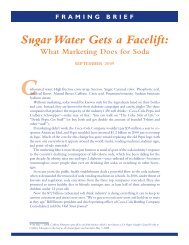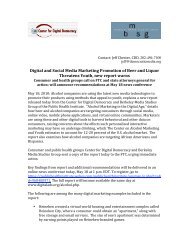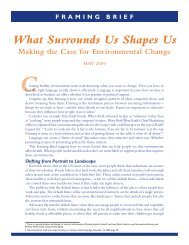"Interactive Food & Beverage Marketing" (PDF)
"Interactive Food & Beverage Marketing" (PDF)
"Interactive Food & Beverage Marketing" (PDF)
You also want an ePaper? Increase the reach of your titles
YUMPU automatically turns print PDFs into web optimized ePapers that Google loves.
22<br />
<strong>Interactive</strong> <strong>Food</strong> & <strong>Beverage</strong> Marketing | Setting the Stage<br />
Tapping into Childhood Development<br />
Market researchers employ the expertise of an increasingly diverse array of specialists<br />
in sociology, psychology and anthropology to explore youth subcultures and conduct<br />
motivational research. 76 A considerable amount of contemporary market research is<br />
focused on identifying ways to tap into the critical developmental stages of childhood. For<br />
example, marketers have closely studied the adolescent process of identity formation, tailoring<br />
their strategies to the key emotional and behavioral experiences that are part of<br />
these important explorations of self. “As teens’ life-stage task is to sort through all kinds<br />
of identity issues,” explained Julie Halpin, CEO and co-founder of the Geppetto Group,<br />
“the money they are given or earn all goes to fuel that drive. How can what I buy help me<br />
define who I am, to myself or the people I care about?” 77 Researchers are also closely<br />
tracking how uses of digital technologies are being integrated into children’s social lives,<br />
and identifying new social and psychographic subcategories, based on sophisticated new<br />
data-gathering and -analysis techniques. For example, the “tween” demographic, which<br />
was introduced by marketers during the 1980s, has become a key focus of research on<br />
digital media. 78 “The transition from childhood to adolescence,” noted a 2006 report by<br />
eMarketer, “marks a turning point in online behavior.” Thus, this age group is a particularly<br />
valuable target for online marketers, explained the report’s author, senior analyst Debra<br />
Aho Williamson. “They are forming brand preferences, and they have comparatively less<br />
skepticism about advertising than older teens and adults.” 79<br />
A 2003 market research report, Born to Be Wired, divided teenagers into definable<br />
market segments, based on their attitudes, behaviors, and use of new media, suggesting<br />
the most effective approaches that companies can use in order to influence<br />
members of each group. For example,<br />
• “Chic Geeks,” are “early adopters of technology and heavy users of gadgetry…<br />
with cell phones as constant companions.” They have “wide social networks<br />
that they actively cultivate,” and they are “conspicuous consumers… looking to<br />
brands to get them noticed” and desiring “new news in their messaging… to be<br />
the first to hear it.” Advertisers, therefore, should “give them a sense of exclusivity<br />
with the information you provide to them,” keeping in mind that “image is<br />
important to them.” 80<br />
• The “Now Crowd” are also heavy media users with large social networks. A<br />
“young segment, largely suburban,” with “a relatively high proportion of African-<br />
Americans,” the “Now Crowd” are “wannabe” leaders. To best appeal to this<br />
group, marketers are advised to offer them “social currency—information that<br />
will raise their standing and credibility” among their peers. “The role of brands<br />
to the Now Crowd is to help ‘brand’ them as being the ‘Now’ Crowd.” But companies<br />
are warned not to let members of this subgroup down because “they are<br />
influential and can spread negative word-of-mouth quickly.” 80









